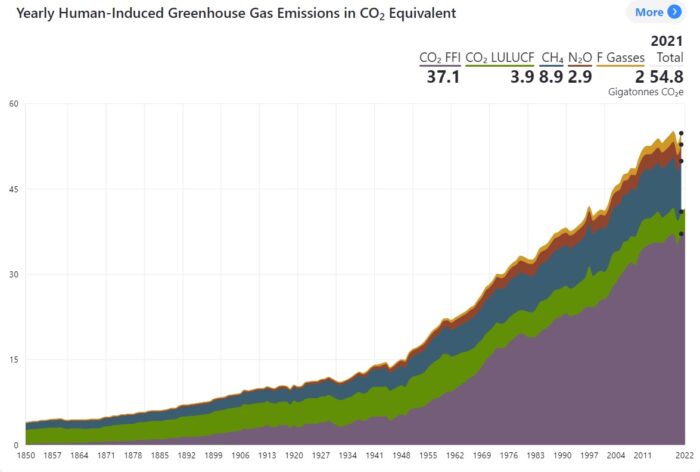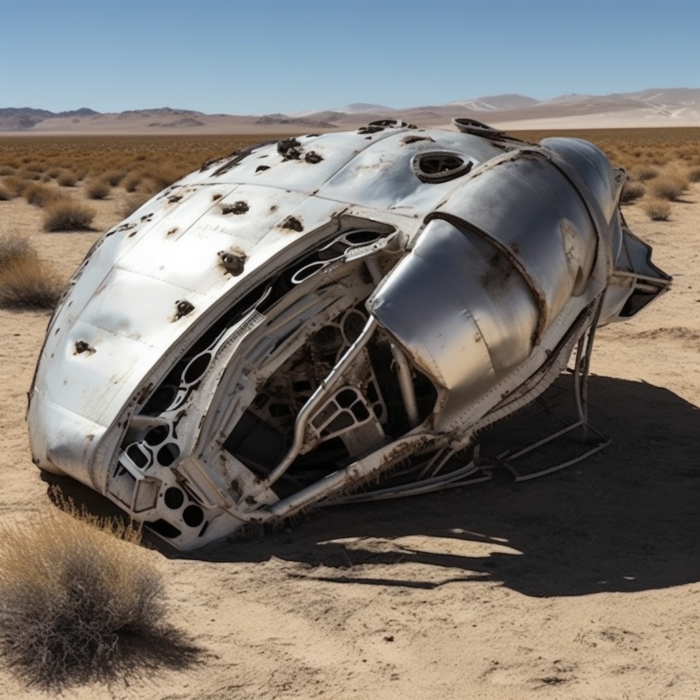Jun
09
2023
 There is good evidence that if you want to lose weight, you need to weigh yourself at least weekly. You need the constant feedback of the scale to adjust your behavior. This is a good general principle – having outcome feedback to measure the effect of what you are doing so you can make adjustments. This is the basic concept of many AI learning algorithms. Plug output into input and let it run.
There is good evidence that if you want to lose weight, you need to weigh yourself at least weekly. You need the constant feedback of the scale to adjust your behavior. This is a good general principle – having outcome feedback to measure the effect of what you are doing so you can make adjustments. This is the basic concept of many AI learning algorithms. Plug output into input and let it run.
Along these lines, a group of 50 scientists have made a website and report that tracks several useful measures of how the world is doing tackling climate change. They are doing this in part in preparation for the upcoming (and future) IPCC meetings. But it’s also a useful resource for journalists and the public. So – how are we doing? Brace yourself.
One measure they track is the average warming (above pre-industrialized levels) averaged over the last decade running. This helps track one of the primary goals of trying to blunt global warming, keeping peak warming below 1.5 C (2.7 F). In 2019 this average of the previous 10 years was 1.07 C. In 2022, just three years later, this average is up to 1.14 C. My only “note” is that I would put some kind of thermometer or gauge on the website, visually representing current average warming and how close we are getting to 1.5 C. But the numbers tell the tale.
Another way to mark our march toward problematic climate change is known as the carbon budget – how much cumulative CO2 can we release into the atmosphere without pushing warming past 1.5 C? The remaining carbon budget is 250 gigatonnes of CO2. Our current annual rate of CO2 emissions is 41 gigatonnes – so if we stay at the current rate we will exhaust our carbon budget in 2029 – just 6 years. Remember when it was common to report that “we have just 12 years to stop global warming”? That was based on the carbon budget calculation. That’s not really what it means. It’s more accurate to say, we have 12 years, at current CO2 emissions, before we will exceed 1.5 C warming. That figure has now been cut in half, down to 6 years.
Continue Reading »
Jun
08
2023
 How seriously should we take the claims of David Grusch? He is an airforce veteran and former member of the UAP (unidentified aerial phenomena) task force, which is enough to at least hear him out. He gave an exclusive interview to journalist Ross Coulthart from NewsNation, part of which has been made public. This is sure to stoke the flames of UFO conspiracy theorists, and the media is, of course, loving it. But what is he actually saying, and what is the evidence?
How seriously should we take the claims of David Grusch? He is an airforce veteran and former member of the UAP (unidentified aerial phenomena) task force, which is enough to at least hear him out. He gave an exclusive interview to journalist Ross Coulthart from NewsNation, part of which has been made public. This is sure to stoke the flames of UFO conspiracy theorists, and the media is, of course, loving it. But what is he actually saying, and what is the evidence?
Grusch claims that the UAP task force, which was renamed the All-domain Anomaly Resolution Office (AARO), was not given information that there is a super secret government program for the retrieval and study of “non-human exotic craft” – basically alien spacecraft. This secret program has been operating for decades and has even been hidden from Congress, and therefore has no congressional oversight. He claims to have “proof” that this secret agency exists, although he is not at liberty to reveal any of this evidence for national security reasons. This is really the only claim for which he states he has actual evidence – that such an organization exists within the US government, hidden from Congress and the public.
But he goes further to claim that this program has recovered many crashed or abandoned craft, they have been working to study and reverse-engineer the technology, that they have also recovered alien bodies, and that this has been going on for decades. Further, many other countries have similar programs and have also recovered alien craft, creating a race to reverse engineer the technology for strategic advantage. He has no evidence that any of this is true, nor has he seen any such evidence himself. He is basing this entirely on hearsay – what he claims other intelligence officers have told him.
I have many questions, and I remain profoundly skeptical of these claims. The overall story does not sound credible or make sense. But let’s break it down a bit.
Continue Reading »
Jun
06
2023
 Since we are in a “all hands on deck” situation when it comes to climate change, we need to take a look at all potential strategies for delaying and blunting global warming. The game at this point is all about peak warming – how much will the Earth warm before temperatures peak and then start to come down again (assuming we eventually drastically reduce our collective carbon footprint). This is not a win-lose, all-or-nothing scenario. It is very much a sliding scale – the higher peak warming is, the greater the chance of hitting some nasty tipping points and the greater the disruption to life and civilization.
Since we are in a “all hands on deck” situation when it comes to climate change, we need to take a look at all potential strategies for delaying and blunting global warming. The game at this point is all about peak warming – how much will the Earth warm before temperatures peak and then start to come down again (assuming we eventually drastically reduce our collective carbon footprint). This is not a win-lose, all-or-nothing scenario. It is very much a sliding scale – the higher peak warming is, the greater the chance of hitting some nasty tipping points and the greater the disruption to life and civilization.
Current evidence indicates that if we keep at 1.5 C warming or below (we are currently at 1 C warming) then we will probably be OK. If we exceed 2.5 C then there will very likely be disastrous results. Between 1.5 and 2.5 there is uncertainty. We don’t know precisely where the tipping points are (where will the Antarctic glaciers fail and essentially slide into the ocean), or exactly how bad things will get at each degree above 1.5. The problem is, we will almost certainly land somewhere between 1.5 and 2.5 C. So every bit we do to reduce that peak warming will likely have measurable benefits. For any intervention, therefore, the question is not whether or not it will prevent global warming, but rather how much will it likely reduce peak warming and lower the odds of the really bad stuff happening. This is why many experts believe we need an “all of the above” strategy. Every little bit helps.
With that in mind, what is the potential for reducing peak warming by maximizing living carbon sinks? Often this question is framed with respect to the most obvious living carbon sink – trees. Can we “prevent” global warming by planting a trillion trees, which should be framed as, how much does planting trees contribute to reducing peak warming. We can also frame it as, can we keep at or below a certain level (such as 1.5 C) if we plant enough trees?
Continue Reading »
Jun
05
2023
 We are still very much in the hype phase of the latest crop of artificial intelligence applications, specifically the large language models and so-called “transformers” like Chat GPT. Transformers are a deep learning model that use self-attention to differentially weight the importance of its input, including any recursive use of its own output. This process has been leverage with massive training data, basically the size of the internet. This has produced some amazing results, but as time goes by we are starting to see the real limits of this approach.
We are still very much in the hype phase of the latest crop of artificial intelligence applications, specifically the large language models and so-called “transformers” like Chat GPT. Transformers are a deep learning model that use self-attention to differentially weight the importance of its input, including any recursive use of its own output. This process has been leverage with massive training data, basically the size of the internet. This has produced some amazing results, but as time goes by we are starting to see the real limits of this approach.
I do see a tendency for a false dichotomy when it comes to AI – with AI is all hype at one end of the spectrum, to AI is going to save/destroy the world at the other. This partly follows the typical trend to overestimate short term technological process on the hype end, to underestimating long term progress on the cynical end. I think reality is somewhere in between – this latest crop of AI applications is extremely powerful, but has its limits and will not simply improve indefinitely.
I have been using several AI programs, like Chat GPT and Midjourney, extensively, and the limitations become more clear over time. The biggest limitation of these AI apps is that they cannot think the way people do. They mimic the output of thinking, without any true understanding. They do this by being training on a massive database, and using essentially statistics to predict what comes next (what word fragment or picture element). This produces some amazing results, and it’s still shocking that it works so well, but also creates interesting fails. In Midjourney, for example, (and AI art production application) when creating your prompts that result in image options, you can’t really explain to the application the way you would to a person what it is you want. You are trying to find the right triggers, but those triggers are quirky, and are highly dependent on the training data. Using different words to describe the same thing can trigger wildly different results, based upon how those words were used in the training data.
The same is true of Chat GPT. The more unusual your request the more quirky the result. And the results are not based strictly on reality, just statistically how words are used. This is why there is a problem with so-called hallucinations. You are getting a statistically probable answer, not a real answer, and quirks in the data will produce quirks in the result. The problem has no real understanding of what it’s saying. It’s literally just faking it, mimicking human language by statistically reconstructing what it has learned.
Continue Reading »
Jun
02
2023

What will be the ultimate fate of our universe? There are a number of theories and possibilities, but at present the most likely scenario seems to be that the universe will continue to expand, most mass will eventually find its way into a black hole, and those black holes will slowly evaporate into Hawking Radiation, resulting in what is called the “heat death” of the universe. Don’t worry, this will likely take 1.7×10106 years, so we got some time.
But what about objects, like stellar remnants, that are not black holes? Will the ultimate fate of the universe still contain some neutron stars and cold white dwarfs that managed to never get sucked up by a black hole? To answer this question we have to back up a bit and talk about Hawking Radiation.
Stephen Hawking famously proposed this idea in 1975 – he was asked if black holes have a temperature, and that sent him down another type of hole until Hawking Radiation popped out as the answer. But what is Hawking Radiation? The conventional answer is that the vacuum of space isn’t really nothing, it still contains the quantum fields that make up spacetime. Those quantum field do not have to have zero energy, and so occasionally virtual particles will pop into existence, always in pairs with opposite properties (like opposite charge and spin), and then they join back together, cancelling each other out. But at the event horizon of black holes, the distance at which light can just barely escape the black hole’s gravity, a virtual pair might occur where one particle gets sucked into the black hole and the other escapes. The escaping particle is Hawking Radiation. It carries away a little mass from the black hole, causing it to glow slightly and evaporate very slowly. This evaporation gets quicker as the black hole becomes less massive, until eventually it explodes in gamma radiation.
Continue Reading »
Jun
01
2023
 I did not plan to write yet another post about energy, but this popped up and I had to write about it. UMASS researchers have produced a device that generates electricity by harvesting charge from water vapor. They write:
I did not plan to write yet another post about energy, but this popped up and I had to write about it. UMASS researchers have produced a device that generates electricity by harvesting charge from water vapor. They write:
The common feature of these materials is that they are engineered with appropriate nanopores to allow air water to pass through and undergo dynamic adsorption–desorption exchange at the porous interface, resulting in surface charging. The top exposed interface experiences this dynamic interaction more than the bottom sealed interface in a thin-film device structure, yielding a spontaneous and sustained charging gradient for continuous electric output.
Mainstream reporting, which made national news, has been mediocre, although some better than others. Author Jun Yao states that the device is like an artificial cloud, but instead of building up a charge that gets released as lightening, it harvests a tiny amount of current. The key is not in the material itself, but its structure – which requires nanopores less than 100 nm wide. Obviously this is a proof-of-concept laboratory phenomenon. Yao claims this can be a source of large amounts of continuous clean energy.
I have lots of questions, and reporting so far has only touched on them. My first question is – how will this scale? Yao reports you could stack a billion such devices into an appliance the size of a refrigerator which could generate 1 kw of power. The average American home requires an average of 1.2 kw of power, but can draw 3-5 at peak demand. So we are in the ballpark with 1 kw. Assuming this all works and scales (a big assumption I am not willing to make) I can envision appliances perhaps the size of a mini-fridge, producing 200 watts power, which can be chained together to produce whatever power a particular building needs.
Continue Reading »
 There is good evidence that if you want to lose weight, you need to weigh yourself at least weekly. You need the constant feedback of the scale to adjust your behavior. This is a good general principle – having outcome feedback to measure the effect of what you are doing so you can make adjustments. This is the basic concept of many AI learning algorithms. Plug output into input and let it run.
There is good evidence that if you want to lose weight, you need to weigh yourself at least weekly. You need the constant feedback of the scale to adjust your behavior. This is a good general principle – having outcome feedback to measure the effect of what you are doing so you can make adjustments. This is the basic concept of many AI learning algorithms. Plug output into input and let it run.
 How seriously should we take
How seriously should we take Since we are in a “all hands on deck” situation when it comes to climate change, we need to take a look at all potential strategies for delaying and blunting global warming. The game at this point is all about peak warming – how much will the Earth warm before temperatures peak and then start to come down again (assuming we eventually drastically reduce our collective carbon footprint). This is not a win-lose, all-or-nothing scenario. It is very much a sliding scale – the higher peak warming is, the greater the chance of hitting some nasty tipping points and the greater the disruption to life and civilization.
Since we are in a “all hands on deck” situation when it comes to climate change, we need to take a look at all potential strategies for delaying and blunting global warming. The game at this point is all about peak warming – how much will the Earth warm before temperatures peak and then start to come down again (assuming we eventually drastically reduce our collective carbon footprint). This is not a win-lose, all-or-nothing scenario. It is very much a sliding scale – the higher peak warming is, the greater the chance of hitting some nasty tipping points and the greater the disruption to life and civilization. We are still very much in the hype phase of the latest crop of artificial intelligence applications, specifically the large language models and so-called “transformers” like Chat GPT. Transformers are a deep learning model that use self-attention to differentially weight the importance of its input, including any recursive use of its own output. This process has been leverage with massive training data, basically the size of the internet. This has produced some amazing results, but as time goes by we are starting to see the real limits of this approach.
We are still very much in the hype phase of the latest crop of artificial intelligence applications, specifically the large language models and so-called “transformers” like Chat GPT. Transformers are a deep learning model that use self-attention to differentially weight the importance of its input, including any recursive use of its own output. This process has been leverage with massive training data, basically the size of the internet. This has produced some amazing results, but as time goes by we are starting to see the real limits of this approach.
 I did not plan to write yet another post about energy, but this popped up and I had to write about it.
I did not plan to write yet another post about energy, but this popped up and I had to write about it. 




